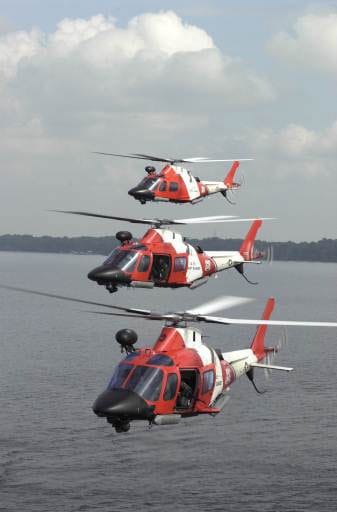MH-68A Stingrays
The United States Coast Guard’s Helicopter Interdiction Tactical Squadron (HITRON) seizures and set the stage for the continued airborne use of force in maritime drug interdiction efforts. Due to the success during the test and evaluation stage, the HITRON program was validated and designated a permanent Coast Guard unit. HITRON grew to 40 personnel to halt the rising tide of go-fast drug smugglers, and a requirement for eight helicopters was determined necessary to meet cutter deployment cycles. Competitive bids were solicited and in March 2001, an agreement with Agusta Aerospace Corporation was made to lease eight A109E Power helicopters. HITRON Jacksonville faced many new challenges as they converted a civilian corporate helicopter into an armed shipboard deployable aircraft. These aircraft were equipped with the latest radar and Forward Looking Infrared sensor system capable of recording activities on tape to facilitate prosecution. HITRON armed these helicopters with M-16 5.56mm rifles and M240 7.62mm machine guns for warning shots and self-protection, and the RC50 laser-sighted .50 caliber precision rifle to disable the engines of non-compliant suspect vessels. They were given the military designation of MH-68A.
Initial flight training and aerial gunnery were established and validated by HITRON pilots and gunners. Night shipboard landings, a first for the Coast Guard and now operational procedure Coast Guard wide, were initiated using the ANVIS-9 Night Vision Goggles integrated with the ANVIS-7 heads-up display (HUD) system, and were the first users in the world to operate the latest generation of these night vision devices.
For counter drug operations, HITRON aircrews forward deploy aboard Coast Guard cutters for 30-60 day deployments, and aircrews are typically deployed about 120 days a year total. While on deployment, the go-fasts are hunted not only by the MH-68A but also by maritime patrol aircraft (MPA) such as the Coast Guard HC-130H Hercules. If an MPA locates a go-fast, the HITRON crew launches from the cutter and proceeds to the go-fast intercept location. The crew then approaches the suspect vessel with weapons trained on the vessel solely for self-protection. Once over the suspect vessel, the helicopter crew confirms the nationality or lack of nation status and whether the vessel is in fact a suspect smuggling vessel. The aircrew will then attempt to convince the boat crew to stop through the use of sirens, loud speakers, visual hand signals, and radio communications in both English and Spanish. If the vessel stops during this phase, it is boarded and searched by the cutter’s boat crew who accompany the chase in an over-the-horizon pursuit boat. If the vessel is found to be carrying drugs, the cutter crew will take appropriate law enforcement actions. If the suspect vessel fails to stop after these numerous visual and verbal warnings, the helicopter crew will take up a firing position alongside the go-fast and fire warning shots across their bow to further compel them to stop. If the warning shots do not convince the suspects to stop, the helicopter crew prepares to disable the vessel by shooting out the go-fast’s engines. Using precision, laser-sighted .50 caliber rifles, the helicopter crew positions themselves alongside the fleeing go-fast for disabling shots. Most of the go-fasts have multiple engines, and the helicopter crew will continue to fire into these engines until the suspects stop or they are forced to stop. Once stopped, the vessel will be boarded by the Coast Guard pursuit boat crew and the smugglers taken into custody.
Due to HITRON’s unique capabilities, the unit was directed to develop tactics to meet the terrorist threats facing the United States. Aircrews now deploy where needed, working with surface assets, to provide a layered defense to the maritime domain.
On 27 January 2008 the last MH-68A was formally transferred back to Agusta, ending a partnership which resulted in the interdiction of 126 vessels, 159 tons of cocaine valued at 8.7 billion dollars and the apprehension of 465 narco-smugglers. The MH-68A Stingray was replaced by the MH-65C Dolphin helicopter as the HITRON interdiction and security aircraft.
It had been planned to use the HH-65 in an airborne use of force role but implementation was delayed until the aircraft was retrofitted with more powerful and reliable Arriel 2C2-CG engines to handle the flight profile and increased operational weight. By September of 2007 all HH-65Cs had been re-engined and the Coast Guard began upgrading the HH65C adding sensors and equipment required for this complicated mission. The decision to selectively upgrade the HH-65C into a weaponized MH-65C significantly enhanced HITRON’s multi-mission capabilities while utilizing a standard Coast Guard aircraft has greatly improved maintenance and logistic support.

HITRON Jacksonville took delivery of the first MH-65C on 19 October 2007; pilots and crew began training 4 short days later. A tremendous team effort from all departments and personnel resulted in the first MH-65C deployment leaving as scheduled on 26 January 2008 for an AUF CD patrol embarked aboard Coast Guard Cutter DALLAS.
HITRON has assisted many foreign military organizations including the British and Dutch Royal Navies in developing AUF programs of their own to assist in the War on Drugs. The US Navy has also solicited HITRON to assist with developing their AUF program along with Coast Guard Law Enforcement Detachments (LEDET) to expand the US’s counter drug assets in the Caribbean Sea and the Eastern Pacific Ocean. Due to HITRON’s success, Coast Guard’s Ports, Waterways and Coastal Security (PWCS) AUF capability has expanded and many of the Coast Guard’s existing air stations are armed and able to provide airborne security to every major port in the United States. During the first 14 years of operation, beginning in 1998, HITRON has been directly involved in the interdiction of 244 drug smuggling boats carrying a total of 249 tons of cocaine and 14 tons of marijuana with an import value of more than $11 billion.

